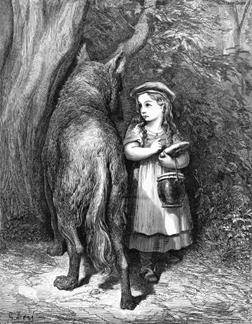LITERATURE
 | "Red Riding Hood meets old Father Wolf"
by Gustave Doré |
Fairy Tale Scares Children
Copyright © 2012, 2017 Timothy S. Klugh. All Rights Reserved.

I came across this several-year-old news article about a visiting teacher who read a very old fairy tale called "Little Red Hat" to children in third and fourth grade classes at a school in Harris County, Georgia. The tale scared a child so bad it gave her nightmares. The visiting teacher was made to apologize to the classes after complaints from parents were received by the school.
Now, let's consider the fact that the teacher read the students one of the most grotesque of the old fairy tales. "Little Red Hat" and “Little Red Riding Hood” are spin-off tales of the original “The Little Red Cap (Le Petit Chaperon Rouge)” first written by Charles Perrault in 1697. Where “The Little Red Cap (Le Petit Chaperon Rouge)” story has the young naïve girl attacked by the wolf and eaten, the young girl deals with a wolf in “Little Red Riding Hood” as well, but in “Little Red Hat” she faces an ogre, a human-like creature, and so it includes cannibalism.
However, in defense of fairy tales like "Little Red Hat", let me state the seemingly lost fact that most fairy tales were not soft love stories about boy who loves some girl. Fairy tales served an even more important purpose. They were used to be works of metaphor, morality, warning, history, deception, danger, consequence, and the struggle of good and evil. “The Little Red Cap (Le Petit Chaperon Rouge)”, "Little Red Hat" and "Little Red Riding Hood" are tales that are warnings about young girls talking to strangers. All of these tales are meant to scare the truth of the consequences of trusting someone who should not be trusted. In “The Little Red Cap (Le Petit Chaperon Rouge)” and "Little Red Hat" the poor girl dies. In "Little Red Riding Hood" some huntsmen kills the wolf and the young girl is saved. The moral is the same for all these tales: Don't go into the woods alone and don't trust strangers. These stories masterfully did their job of driving the point home to scared little children for centuries and probably saved many of their lives at the same time.
Another thing here is, are scary stories wrong? If they are, then you best avoid many fairy tales. You'll find some scary stuff that will disturb even adults. However, what is wrong with scary? I was told some scary stories when I was a child. I saw some scary movies too. Yes, indeed those stories and movies gave me nightmares... but I got past it. It's normal fun. In fact, many of us seek out entertainment to scare us. How many times do children ask to hear ghost stories around Halloween? When my son had nightmares, I told him they would pass. I also told him to use those nightmares and perhaps write his own stories based on them. Take a "bad" and make it productive!
However, the most ironic thing about this news article is that, right after lambasting the teacher with such outrage and shock... after describing how horrific the tale of "Little Red Hat" is... the article included a full retelling of the "Little Red Hat" story at the bottom of the article. Really?!
This is my conclusion: Fairy tales, fables, and nursery rhymes were not always meant to comfort children or adults. They were lessons that could be as disturbing and gory as some stories from the Holy Bible. The problem is that today's parents do not know the value of fairy tales nor do they know how to apply the tales. In fact, many parents do not even know these tales other than what Disney has told them. Fairy tales, no matter how old, should not be deemed inappropriate. They have been preserved through the generations by people who felt they were important enough to pass on to the next generation. They do not all end in a good way. It is up to the adult to know the fairy tale and know how they intend to use it. Adults should read fairy tales to children (as my father did for me) (as I did for my son) and then discuss the story and the morals in it. Fairy tales have much to teach us.
Written on 10/15/2012
Revised on 05/27/2017
Page Range: 1 - 2
|
|